|
Scyrotis athleta (Jumping-ball moth)
Life
> Eukaryotes >
Opisthokonta >
Metazoa (animals) > Bilateria > Ecdysozoa
> Panarthropoda > Tritocerebra > Phylum:
Arthopoda > Mandibulata >
Atelocerata > Panhexapoda >
Hexapoda
> Insecta (insects) > Dicondyla > Pterygota >
Metapterygota > Neoptera > Eumetabola > Holometabola > Panorpida > Amphiesmenoptera
> Lepidoptera >
Glossata >
Coelolepida >
Myoglossata >
Neolepidoptera >
Heteroneura >
Incurvarioidea > Family:
Cecidosidae > Scyrotis
In the sand and leaf-litter beneath Searsia lucida
(= Rhus lucida), one can sometimes see
small (about 6 mm) oval balls that jump. In the ball is the larva of a moth,
Scyrotis athleta (family Cecidosidae). The movement and jumping is a
response to heat and facilitates repositioning of the ball into ideal pupating
conditions in the soil and leaf-litter. It is quite a mystery how such a small
larva in such a confined space is able to exert the force required to jump (up
to 10 cm). Janse (1920) concluded that it is done by careful
positioning inside the ball and rapid contracting and relaxing of muscles.
The balls start off as bumps (galls) that form on the leaves of
Searsia
lucida. A female moth lays her egg probably by inserting her ovipositor into
the leaf. The gall is formed around
the hatched larva possibly as a result of the feeding action inside the leaf.
This is still being investigated. The larva feeds
inside the gall and when mature the external layer of the gall bursts open and
the ball falls to the ground. Jumping can continue for up to 6 weeks and the
moth emerges a few months later.
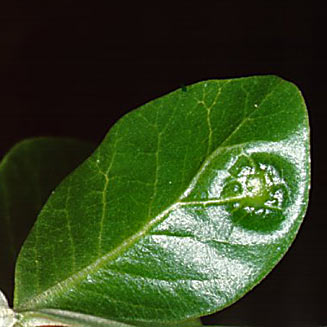 |
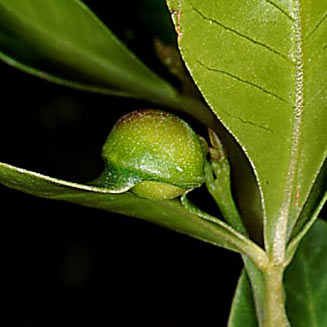 |
|
Gall beginning to develop where a moth egg has been
laid on the leaf. [photo V.B. Whitehead, Iziko
©] |
Gall on leaf of Searsia lucida. [photo V.B.
Whitehead, Iziko ©] |
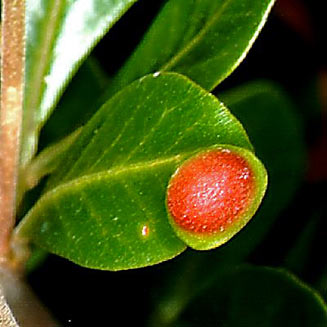 |
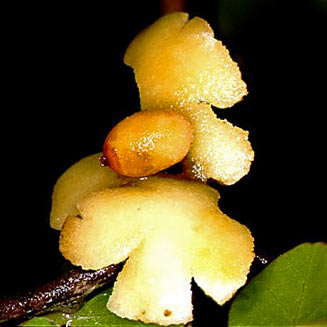 |
|
Gall on leaf of Searsia lucida. [photo V.B.
Whitehead, Iziko ©] |
Gall where the external layer has burst open showing
the jumping ball that will fall to the ground. [photo V.B. Whitehead,
Iziko ©] |
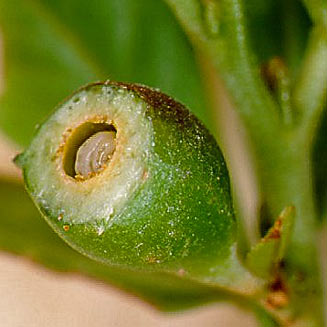 |
 |
|
Cross-section of the gall revealing the larva
within. [photo V.B. Whitehead, Iziko ©] |
The moth, Scyrotis athleta (wing
span about 10 mm). [photo V.B. Whitehead, Iziko
©] |
However, the story does not end there. There are wasps that parasitize the
galls. The female wasp of the family Cynipidae lays her eggs in the gall causing
the gall to callous, killing the moth larva but allowing the parasitic wasp
larva to develop. The calloused gall does not fall from the plant and the 3 mm
adult wasps emerge the following year in June.
There are other similar jumping species that occur in South
Africa. There is a moth (family Incurvariidae) associated with proteas and
another (family Pyralidae) associated with Euphorbiaceae. These are different
from the originator of the term, the Mexican jumping bean, that is in fact a
seed of a shrub (genus Sebastiana) in which the larva of a moth, Carpocapsa
saltitans (family Tortricidae), develops into a cocoon.
Reference
Text by M. Cochrane, V.B. Whitehead and S. van
Noort.
|
